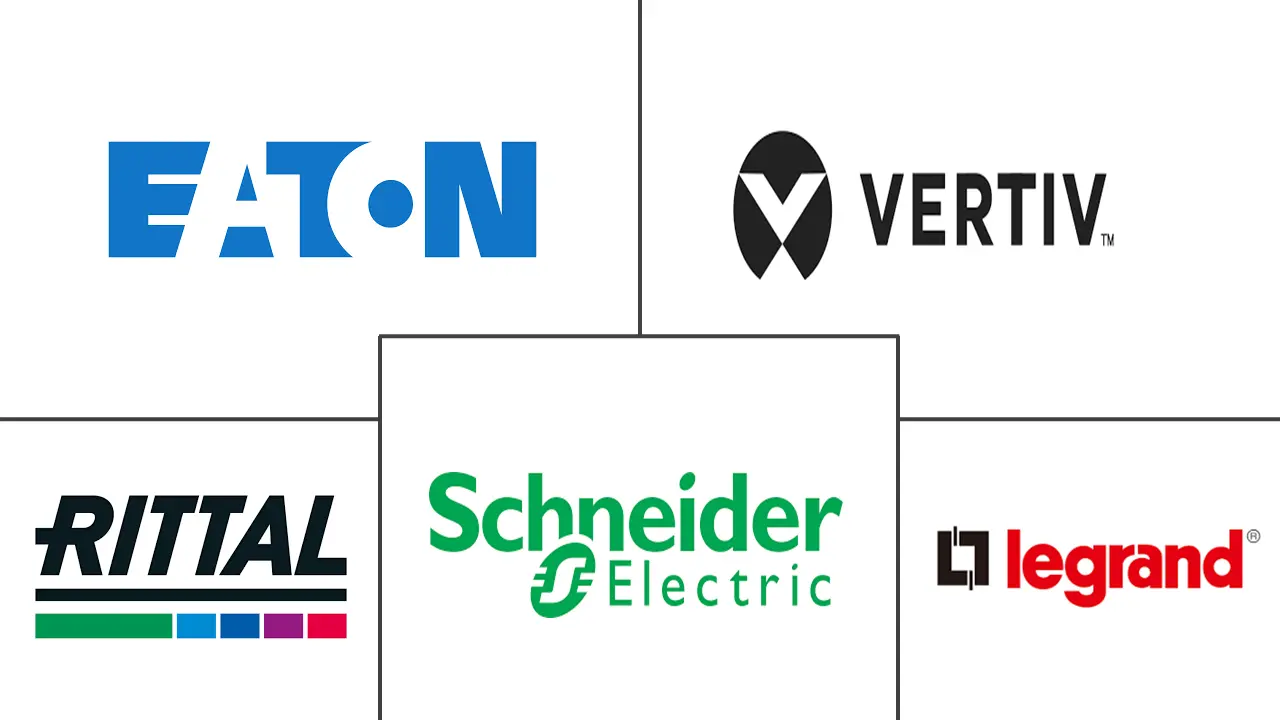Middle East Data Center Rack Market Size and Share
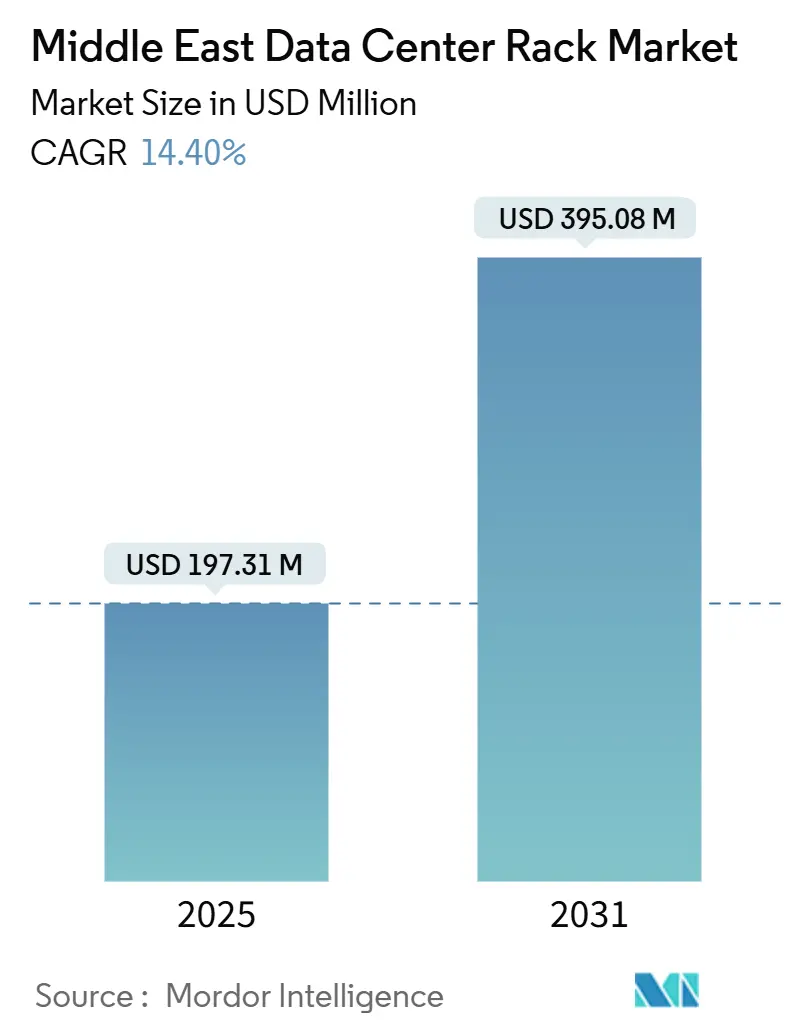
Middle East Data Center Rack Market Analysis by Mordor Intelligence
The Middle East Data Center Rack market size stands at USD 197.31 million in 2025 and is forecast to reach USD 395.08 million by 2030, advancing at a 14.9% CAGR. Expansion is fueled by sovereign AI programs, hyperscale investments, and aggressive digital-government agendas that are tripling regional data-center capacity and driving demand for dense, climate-resilient rack infrastructure. Hyperscalers are standardizing higher-power racks to host GPU clusters approaching 50 kW per rack, while government procurement rules that favor local assembly shorten lead times and reshape competitive dynamics. Material substitution toward aluminum and composites is gathering pace as 50% steel tariffs inflate costs, and desert-specific cooling requirements encourage enclosed designs that mitigate dust and heat. The Middle East Data Center Rack market is therefore evolving from cost-driven commodity supply to a premium solutions business where thermal performance, local content, and rapid deployment determine success.
Key Report Takeaways
- By rack size, Full Rack configurations captured 74.3% of Middle East Data Center Rack market share in 2024; Half Rack solutions are projected to grow at 16.2% CAGR through 2030.
- By rack height, the 42U segment led with 61.3% revenue share in 2024, while 48U solutions are forecast to expand at a 17.3% CAGR to 2030.
- By rack type, Cabinet (Closed) racks accounted for 85.4% of the Middle East Data Center Rack market size in 2024 and will advance at 15.8% CAGR during the outlook period.
- By data-center type, Colocation facilities held 51.6% share in 2024, whereas hyperscaler deployments record the highest projected CAGR at 17.4% to 2030.
- By material, steel maintained 78.4% share in 2024; aluminum racks are set to grow at 17.2% CAGR on tariff and corrosion-resistance advantages.
• By geography, Saudi Arabia led with 38.4% Middle East Data Center Rack market share in 2024, while the UAE is the fastest-growing country at 16.3% CAGR.
Middle East Data Center Rack Market Trends and Insights
Drivers Impact Analysis
| Driver | % Impact on CAGR Forecast | Geographic Relevance | Impact Timeline |
|---|---|---|---|
| Hyperscale build-outs by cloud majors in Saudi Arabia and UAE | +3.2% | Saudi Arabia & UAE core, spillover to Qatar | Medium term (2-4 years) |
| Accelerated local-content requirements driving on-shore colocation demand | +2.8% | GCC-wide, strongest in Saudi Arabia | Short term (≤ 2 years) |
| 5G-led edge sites requiring micro-module racks | +2.1% | Urban centers across Middle East | Medium term (2-4 years) |
| Sovereign-AI and HPC investments (Qatar, KSA) | +3.5% | Qatar & Saudi Arabia, expanding to UAE | Long term (≥ 4 years) |
| Renewable-energy PPA incentives lowering opex for rack densification | +1.8% | UAE & Saudi Arabia leading | Long term (≥ 4 years) |
| Micro-climate resistant enclosures for desert environments | +1.4% | Regional, concentrated in extreme climate zones | Medium term (2-4 years) |
| Source: Mordor Intelligence | |||
Hyperscale build-outs by cloud majors in Saudi Arabia and UAE
Saudi Arabia and the UAE anchor a hyperscale construction wave that requires thousands of GPU-ready racks capable of liquid cooling and 600 kW power feeds. Microsoft’s USD 545 million partnership with du exemplifies the scale of incoming demand, while the planned 5 GW AI campus in the UAE will absorb order volumes that could triple regional rack consumption within two years.[1]Microsoft Corporation, “du and Microsoft Partner to Accelerate UAE Hyperscale Cloud Expansion,” microsoft.com Vendors that pre-qualify for multi-year framework agreements will lock in volume visibility and gain leverage on component sourcing. This driver strengthens the Middle East Data Center Rack market by rewarding suppliers able to integrate cooling distribution, power management, and security features within modular enclosures.
Accelerated local-content requirements driving on-shore colocation demand
Regulations now oblige operators to source predefined percentages of infrastructure from domestic facilities, prompting rack makers to establish GCC assembly lines that cut delivery times from 16 weeks to 6 weeks. Saudi Arabia's Data Center Services Regulations and the UAE's AI Strategy signal expanding localization thresholds that elevate compliant suppliers and marginalize import-dependent rivals. Near-shoring also improves service responsiveness, a critical factor given compressed construction timelines for AI factories.
Sovereign-AI and HPC investments
National AI factories in Saudi Arabia and Qatar feature racks equipped with biometric locks, electromagnetic shielding, and redundant power trunks that support direct-to-chip liquid cooling.[2] International Trade Administration, “Saudi Arabia – Customs Regulations,” trade.gov These hardware commitments alone translate into tens of thousands of racks optimized for 50 kW densities and closed-loop thermal systems.. As similar sovereign projects proliferate, demand concentrates in premium, security-enhanced enclosures, driving higher average selling prices and sustaining the growth of the Middle East Data Center Rack market.
5G-led edge sites requiring micro-module racks
Widespread 5G rollout is spawning compact, ruggedized edge data centers installed on rooftops, towers, and retail sites. Projects such as TAWAL’s micro-edge deployment use vibration-resistant enclosures with wide temperature ranges and integrated battery systems, pushing rack design beyond the conventional data-hall form factor. Although unit revenue is lower, volume growth and new applications—AI inference, private networks, smart-city analytics—create an expanding sub-segment that supports long-run market diversification.
Restraints Impact Analysis
| Restraint | % Impact on CAGR Forecast | Geographic Relevance | Impact Timeline |
|---|---|---|---|
| High import tariffs on steel enclosures in non-FTA countries | -2.1% | Global impact, strongest in non-GCC markets | Short term (≤ 2 years) |
| Limited availability of Tier-IV colocation floor space outside GCC | -1.8% | Jordan, Oman, secondary Middle East markets | Medium term (2-4 years) |
| Growing preference for blade and sled servers reduces rack count | -1.5% | Hyperscale deployments, enterprise refresh cycles | Long term (≥ 4 years) |
| Water-scarcity regulations limiting liquid-cooling retrofits | -2.3% | Desert regions, water-stressed areas | Medium term (2-4 years) |
| Source: Mordor Intelligence | |||
High import tariffs on steel enclosures in non-FTA countries
Steel tariffs rising to 50% worldwide and 5% regional customs duties squeeze vendor margins and inflate customer budgets. Some manufacturers respond by shifting to aluminum alloys or composite frames, yet recertification costs and supply-chain reconfiguration erode short-term profitability. Stronger players are deploying local fabrication to bypass tariffs and preserve price competitiveness, but smaller firms risk exit or consolidation.[3] Huawei Technologies Co., Ltd., “Huawei Unveils AI Data Center Solution in Dubai,” huawei.com
Water-scarcity regulations limiting liquid-cooling retrofits
Stringent water-use policies in the UAE and Saudi Arabia cap industrial withdrawals, making open-loop liquid cooling impractical in most facilities. Operators therefore specify advanced air-cooling or immersion systems that require oversized rack dimensions and sophisticated airflow management. Retrofit projects are especially exposed because existing buildings cannot accommodate closed-loop plumbing without major reconstruction, pushing operators toward greenfield builds that meet water-efficiency criteria from inception
Segment Analysis
By Rack Size: Full Rack dominance driven by AI workloads
Full Rack systems held 74.3% Middle East Data Center Rack market share in 2024 and are projected to grow at 16.2% CAGR through 2030. Hyperscalers standardize 42U and 48U formats to streamline cable routing, power distribution, and in-rack liquid manifolds that support GPU clusters. The Middle East Data Center Rack market benefits because uniform sizing simplifies procurement, reduces installation errors, and accelerates factory-level integration. Half Rack and Quarter Rack solutions remain relevant for edge deployments where space is constrained, yet their contribution to aggregate revenue narrows as AI factories dominate expansion projects.
Full Rack popularity is amplified by sovereign AI factories that require dense compute footprints in secure environments. As rack power envelopes climb toward 50 kW, the incremental cost of a full-height enclosure is minimal relative to the performance gains. Vendors respond by reinforcing frame integrity, integrating hot-aisle containment, and bundling busbar power rails that accommodate future density upgrades. These engineering refinements raise average selling prices, expanding the Middle East Data Center Rack market even when unit volumes plateau.
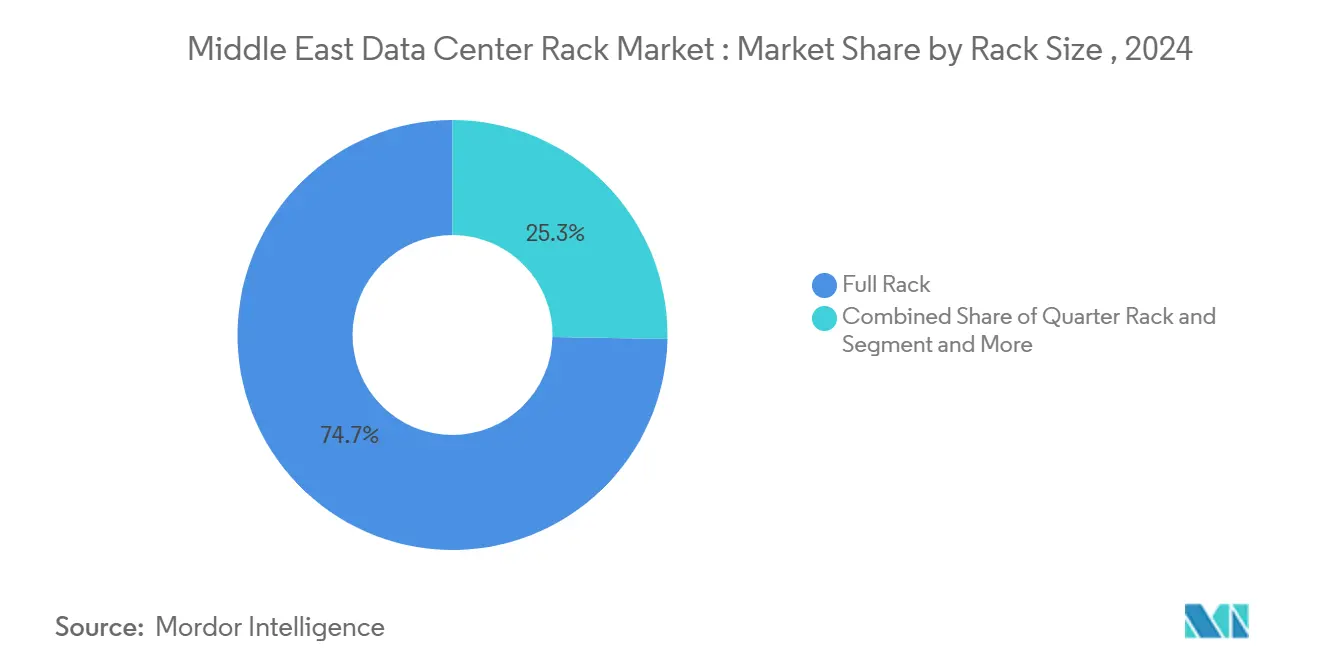
Note: Segment shares of all individual segments available upon report purchase
By Rack Height: 48U emerges as AI-optimized standard
The 42U segment retains 61.3% revenue share, largely because legacy data halls were designed around this height. However, 48U cabinets record the fastest 17.3% CAGR, reflecting AI and HPC designs that need additional vertical room for bigger power distribution units and manifold networking. The Middle East Data Center Rack market size for 48U models is forecast to double by 2028 as hyperscalers retrofit facilities to host NVIDIA GB300 systems.
Height flexibility also aids operators migrating to direct-to-chip liquid cooling, which demands overhead piping and in-rack heat exchangers. 45U configurations serve step-up scenarios where incremental space eases cable congestion without breaching building codes, while ≥52U custom builds appear in mega-scale campuses that can accommodate taller containment corridors. Continuous growth of AI workload intensity anchors 48U cabinets as the de-facto best practice within the Middle East Data Center Rack industry.
By Rack Type: Cabinet security drives market leadership
Cabinet (Closed) racks accounted for 85.4% of the Middle East Data Center Rack market size in 2024 and will advance at 15.8% CAGR. Extreme heat, dust storms, and strict access-control policies make sealed enclosures mandatory for hyperscale and sovereign facilities. Cabinet models integrate particulate filtration, temperature-controlled airflow, and biometric locks that satisfy both environmental and regulatory demands.
Open-frame racks find limited use in highly conditioned halls or test labs, whereas wall-mount units meet edge-and-telecom needs that prioritize space saving. Even where climate is moderated, national security guidelines often compel operators to use closed cabinets with electromagnetic shielding, reinforcing cabinet dominance. Suppliers augment value through sensor-laden door handles, remote locking, and rack-level telemetry, features that differentiate in an otherwise mature product class and enlarge the Middle East Data Center Rack market.
By Data Center Type: Hyperscaler growth reshapes infrastructure
Colocation providers led with 51.6% revenue share in 2024 because enterprises historically preferred shared facilities. The balance is shifting, and hyperscaler campuses are projected to post a 17.4% CAGR that surpasses all other facility models. Hyperscalers sign multi-year offtake agreements that convert pipeline projects into contracted demand, giving rack vendors clearer volume outlooks.
Enterprises continue investing in on-premise and edge sites to comply with data-sovereignty rules and latency targets. Nonetheless, the hyperscaler appetite for standardized, liquid-ready cabinets sets industry specifications that ripple across the supply chain. Modular rack products that can be factory-integrated and container-shipped at scale will capture most of the incremental revenue flowing into the Middle East Data Center Rack market.
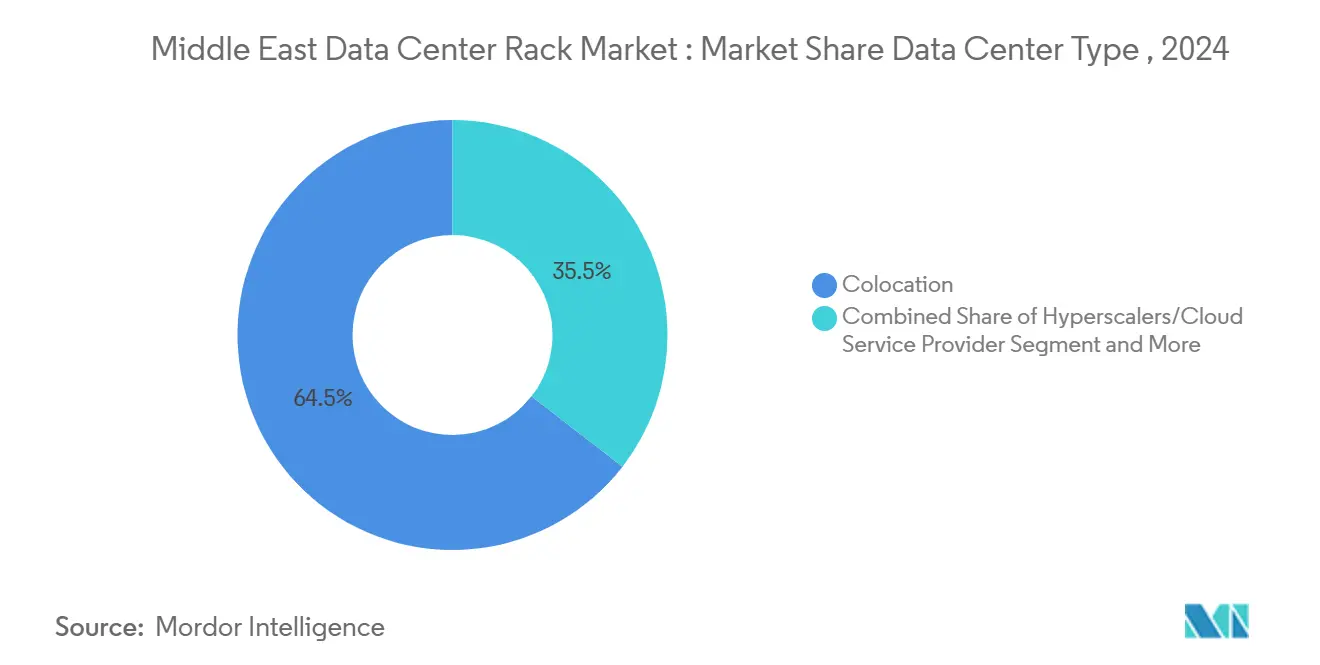
Note: Segment shares of all individual segments available upon report purchase
By Material: Aluminum gains ground despite steel dominance
Steel frames held 78.4% market share in 2024, favored for rigidity and EMI shielding. Yet aluminum cabinets grow at 17.2% CAGR as operators seek weight reduction, rust resistance, and tariff avoidance. Coastal data centers in the UAE report accelerated corrosion of untreated steel, making anodized aluminum attractive despite higher base metal cost.
Composite and hybrid alloys surface in niche high-temperature zones where conductivity and thermal expansion properties outweigh price considerations. Suppliers are incorporating recycled aluminum, aligning with ESG targets and reducing life-cycle emissions. Steel remains dominant where cost prevails, but material diversification ensures the Middle East Data Center Rack market evolves toward lighter, more sustainable construction.
Geography Analysis
Saudi Arabia leads the Middle East Data Center Rack market with 38.4% Middle East Data Center Rack market share in 2024 after earmarking USD 100 billion for digital-infrastructure projects under Vision 2030. Partnerships with to install 500 MW of AI factories make the kingdom the largest single buyer of premium, liquid-cooling-ready enclosures nvidia. Regulatory frameworks mandate local content and enhanced physical security, compelling global vendors to partner with Saudi assemblers to retain eligibility and shorten fulfillment cycles.
The UAE is the fastest-growing geography at 16.3% CAGR, driven by Dubai’s status as an intercontinental connectivity hub and Abu Dhabi’s 5 GW AI campus. Aluminum rack adoption is highest here because coastal humidity accelerates steel corrosion. Government policy that targets full AI-native governance by 2031 translates into continuous hyperscaler expansion, guaranteeing robust rack demand during the forecast window.
Secondary markets—including Qatar, Kuwait, Bahrain, Oman, and Jordan—show rising investment intensity as governments launch localized AI frameworks and 5G deployments. Qatar alone has pledged USD 500 billion for data centers, a figure that can transform supply-chain logistics for vendors that establish regional distribution hubs. Limited Tier-IV floor space and smaller project sizes keep overall share modest, yet edge computing and micro-module racks open profitable sub-segments in these countries.
Competitive Landscape
The supplier base is moderately fragmented, with no vendor exceeding 15% share. Global incumbents such as Schneider Electric, Vertiv, and Huawei compete against regional specialists that engineer dust-proof, high-temperature enclosures. Competitive advantage pivots on integrated power and cooling, local assembly capability, and rapid customization. Suppliers that can pre-assemble racks with busway power, liquid manifolds, and security sensors lower site commissioning time by up to 30%, a benefit valued by hyperscalers racing to bring capacity online.
Strategic differentiation splits into volume play versus premium specialization. Vertiv pursues hyperscale frameworks, bundling racks with thermal-management units, while Saudi fabricators focus on sovereign AI orders that demand biometric locks and electromagnetic shielding. Material engineering is an emerging battleground; firms offering certified aluminum designs bolster position as tariffs push steel costs higher. Partnership activity is intense: KKR’s USD 5 billion alliance with Gulf Data Hub underwrites multi-country capacity expansion and secures anchor orders for affiliated equipment partners.
Mergers and joint ventures are expected as smaller manufacturers lacking local plants face tariff pressures and certification hurdles. Market entry barriers rise with the spread of localization mandates, yet niche innovators remain relevant by addressing edge and micro-module opportunities. The resulting ecosystem gives the Middle East Data Center Rack market a diversified vendor roster even while individual projects concentrate spend among a handful of qualified suppliers.
Middle East Data Center Rack Industry Leaders
-
Schneider Electric SE
-
Vertiv Group Corp.
-
Rittal GmbH & Co. KG
-
Eaton Corporation plc
-
Legrand SA
- *Disclaimer: Major Players sorted in no particular order
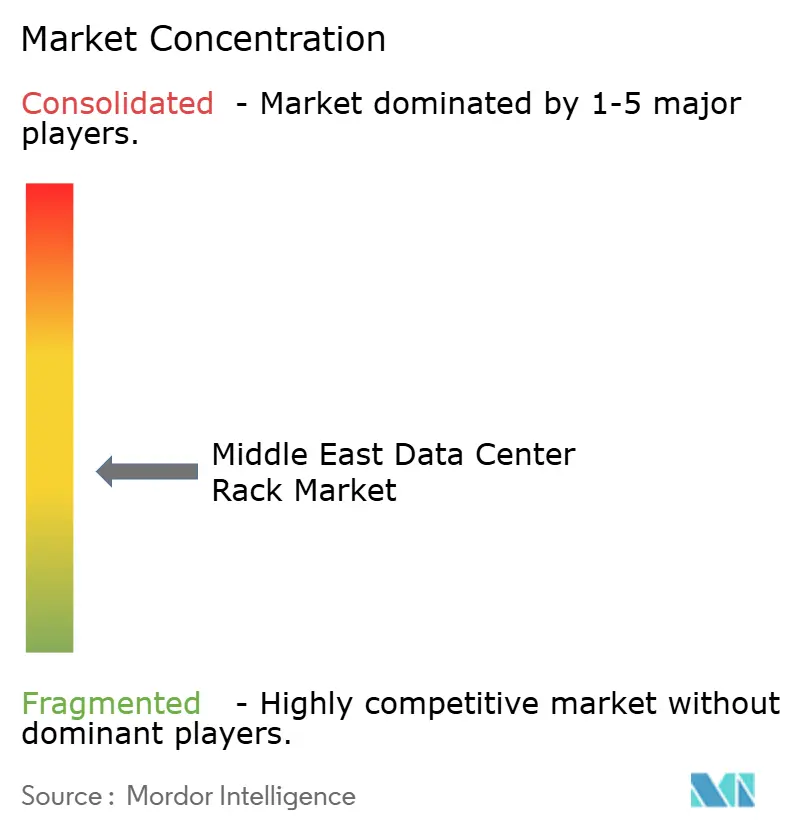
Recent Industry Developments
- May 2025: Huawei unveiled its AI Data Center Solution with PowerPOD architecture at Dubai’s Global Data Center Facility Summit, promoting faster deployment and superior energy efficiency
- May 2025: Microsoft and du launched a USD 545 million partnership to build UAE hyperscale capacity, positioning Microsoft as anchor tenant and du as developer
- May 2025: G42 and US hyperscalers confirmed plans for a 5 GW AI campus in the UAE that will require record numbers of liquid-ready racks
- May 2025: NVIDIA and Saudi Arabia’s Humain agreed to construct 500 MW AI factories using 18,000 GB300 systems, necessitating extreme-density enclosures
Research Methodology Framework and Report Scope
Market Definitions and Key Coverage
Our study defines the Middle East data center rack market as revenue from the sale of new, factory-built enclosures (open-frame or cabinet) that house servers, storage, and networking gear inside commercial, colocation, and hyperscale facilities across Saudi Arabia, United Arab Emirates, Israel, Qatar, Kuwait, Bahrain, Oman, Jordan, and the wider region. We count first-installation shipments only, while replacement racks are tracked as part of yearly demand.
Scope exclusion: We exclude edge micro-cabinets below 6U that go to telecom towers or retail kiosks.
Segmentation Overview
- By Rack Size
- Quarter Rack (>11U)
- Half Rack (12>22U)
- Full Rack (?42U)
- By Rack Type
- Enclosed Cabinet
- Open-Frame
- Wall-Mount and Micro-Edge Enclosure
- By Rack Height (Standard U)
- >24U
- 25>41U
- >42U
- By Deployment Model
- Hyperscale / Cloud
- Colocation
- Enterprise / On-Prem
- By End-User Vertical
- IT and Telecommunication
- BFSI
- Government and Defense
- Media and Entertainment
- Healthcare and Life Sciences
- Other Verticals
- By Country
- Saudi Arabia
- United Arab Emirates
- Israel
- Qatar
- Kuwait
- Bahrain
- Oman
- Jordan
- Rest of Middle East
Detailed Research Methodology and Data Validation
Primary Research
We interviewed colocation operations managers in Riyadh and Dubai, procurement leads at two hyperscalers, facility design consultants, and regional distributors, which let us validate average selling prices, replacement cycles, and shipment lead times that are seldom captured in public sources.
Desk Research
We gathered public data from UN Comtrade HS codes 940320 and 847330, Gulf Cooperation Council customs bulletins, the UAE Telecommunications and Digital Government Regulatory Authority's traffic indexes, IEA data center energy dashboards, and peer-reviewed papers in IEEE Xplore that benchmark rack density. Company 10-Ks, investor decks, and articles on DataCenterKnowledge helped us map near-term facility pipelines. Paid resources include D&B Hoovers for vendor splits, Volza shipment trackers for import volumes, and Dow Jones Factiva for deal flow; they round out the desk model. The list is illustrative; many additional references were reviewed for data checks and clarification.
Market-Sizing & Forecasting
We employ a top-down model that converts announced IT-load additions, existing white space, and historical racks-per-megawatt ratios into annual rack demand. We then corroborate results through sampled ASP × volume roll-ups from leading suppliers. Key inputs include new megawatt capacity, median rack power density, the shift toward ≥48U heights, steel cost indexes, and import tariff schedules. Multivariate regression on these drivers projects the forecast horizon, while scenario analysis tests upside cases seeded by sovereign AI campuses. Gaps in shipment data are bridged by triangulating distributor interviews with customs manifests.
Data Validation & Update Cycle
Model outputs pass anomaly filters, peer review, and senior analyst sign-off before publication. We refresh every twelve months, with interim updates triggered when hyperscale build schedules, tariff rules, or material currency swings alter the outlook.
Why Mordor's Middle East Data Center Rack Baseline Stands Firm
We recognize that published values can differ, and we preview the usual reasons: scope, pricing assumptions, and refresh timing before detailing our stance.
Because our team locks definitions first and revisits them annually, the baseline remains steady even as market noise grows.
Benchmark comparison
| Market Size | Anonymized source | Primary gap driver |
|---|---|---|
| USD 197.31 million (2025) | Mordor Intelligence | |
| USD 175.61 million (2024) | Regional Consultancy A | GCC-only scope; limited validation of hyperscale retrofits |
| USD 221.57 million (2024) | Global Consultancy B | Ancillary hardware bundled; shorter upgrade-cycle assumption |
These contrasts show that Mordor's disciplined scope selection, variable tracking, and multi-layer verification yield a balanced, transparent baseline that decision-makers can trust.
Key Questions Answered in the Report
What is the current size of the Middle East Data Center Rack market?
The market is valued at USD 197.31 million in 2025 and is forecast to reach USD 395.08 million by 2030, reflecting a 14.9% CAGR.
Which rack configuration holds the largest share?
Full Rack systems account for 74.3% of 2024 revenue and remain the dominant choice because they support high-density AI workloads.
Why are aluminum racks gaining traction in the region?
50% global steel tariffs, coastal corrosion, and sustainability targets drive operators toward lighter, rust-resistant aluminum frames that grow at 17.2% CAGR.
How are localization policies shaping vendor strategies?
Saudi and UAE rules mandating domestic content encourage global suppliers to open local assembly lines, reducing lead times and avoiding tariffs.
Page last updated on:
